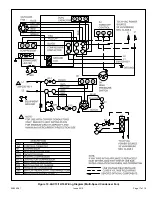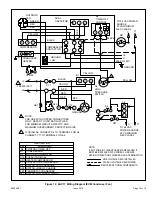
508255-01
Page 13 of 19
Issue 2212
Start-Up
If unit is equipped with a crankcase heater, it should
be energized 24 hours before unit start-up to prevent
compressor damage as a result of slugging.
CAUTION
1. Rotate fan to check for frozen bearings or binding.
2.
Inspect all factory and field-installed wiring for loose
connections.
3. After evacuation is complete, open liquid line and
suction line service valves to release refrigerant
charge (contained in outdoor unit) into system.
4.
Replace the stem caps and secure finger tight, then
tighten an additional 1/6 of a turn.
5. Check voltage supply at the disconnect switch. The
voltage must be within the range listed on the unit
nameplate. If not, do not start equipment until the
power company has been consulted and the voltage
condition corrected.
6. Set thermostat for cooling demand, turn on power to
indoor blower, and close the outdoor unit disconnect
switch to start the unit.
7. Recheck unit voltage with unit running. Power must be
within range shown on unit nameplate.
Refrigerant Charging
Excessive amounts of liquid refrigerant entering the
suction line can damage the compressor. When adding
refrigerant, precautions must be taken to control the
flow of liquid into the system. This can be done by using
a liquid vaporizing adapter or manual control using a
sight glass as indicator.
CAUTION
Units are factory charged with the amount of R-410A
refrigerant indicated on the unit rating plate. This charge is
based on a matching indoor coil and outdoor coil with 15’
line set. For varying lengths of line set, refer to Table 4 for
refrigerant charge adjustment. A blank space is provided
on the unit rating plate to list the actual field charge.
Table 4. Refrigerant Charge Adjustment
Liquid Line Set Diameter
Oz. Per 5 ft. adjust from 15
ft. line set*
3/8 in.
3 oz. per 5 ft.
or 0.6 oz. per 1 ft.
* If line length is greater than 15 ft., add this amount. If line
length is less than 15 ft., remove this amount.
Mineral oils are not compatible with R-410A. If oil must
be added, it must be a polyolester oil.
IMPORTANT
NOTE:
Both airflow and refrigerant charge must be
monitored for proper system set-up. It may be necessary to
alternately check and adjust the airflow and the refrigerant
charge.
If the system is void of refrigerant, or if the outdoor ambient
temperature is cool, use the weigh-in method to charge the
unit. Do this after any leaks have been repaired.
1. Recover the refrigerant from the unit.
2. Conduct a leak check, then evacuate as previously
outlined.
3. Weigh in the charge according to the total amount
shown on the unit nameplate.
If weighing facilities are not available or if unit is being
charged during warm weather, use one of the following
procedures.
•
For systems using a fixed orifice on the indoor
evaporator and outdoor temperatures above
65°F
– charge using the superheat method and table
provided on the unit access panel.
• For systems using a TXV on the indoor evaporator
and outdoor temperature above 60°F
– charge in
cooling mode using the subcooling method and table
provided on the unit access panel.
• For systems below 60°F
– charge in heating mode
using the subcooling method and table provided on
the unit access panel. Attach low pressure gauge
hose to auxiliary service port to access suction side in
heating mode.
NOTE:
All unit table values are based on 70 to 80°F
indoor return air temperature for cooling mode, and
65
°
F to 75°F return air temperature for heat mode.



















